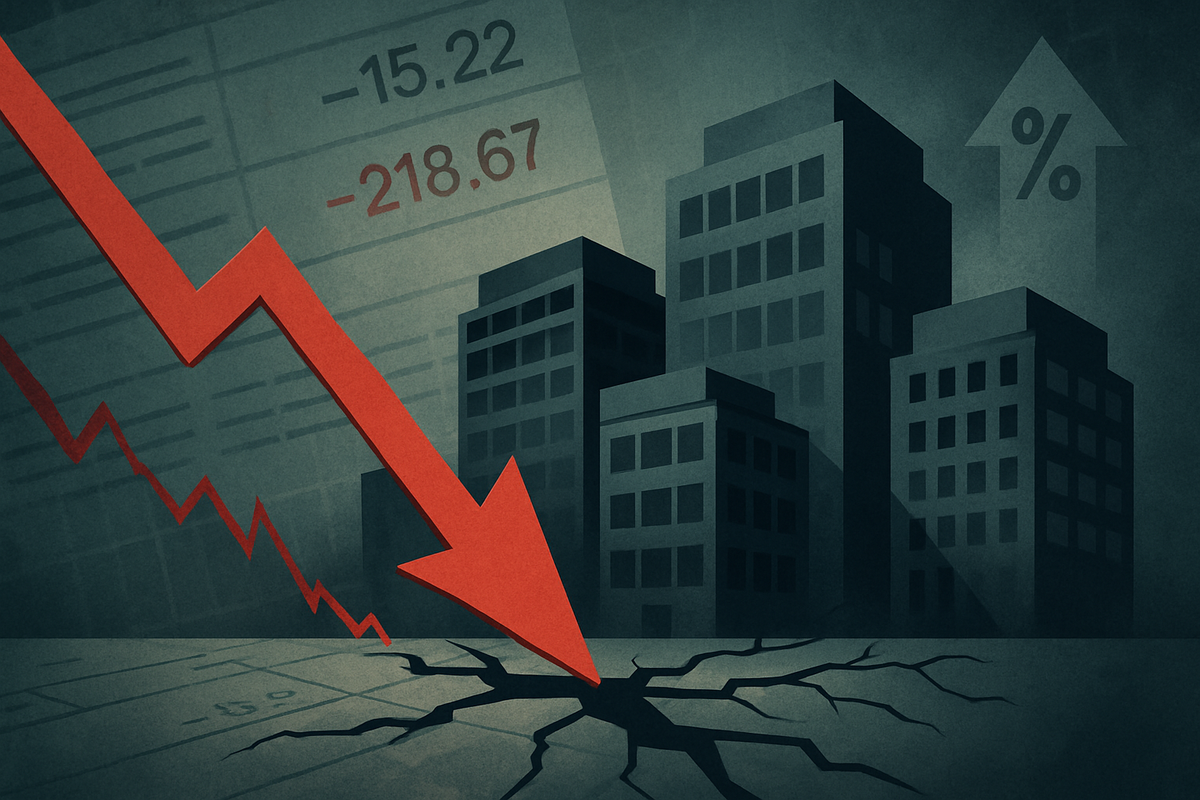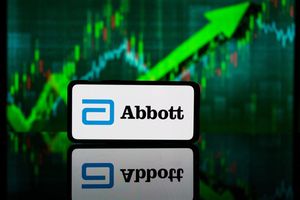
Ares Commercial Real Estate Corporation (NYSE: ACRE) is navigating a turbulent financial landscape, with recent reports revealing a significant contraction in its margin trends. The commercial real estate lender has seen its net interest margin (NIM) nearly halved year-over-year, alongside deeply negative operating and net profit margins. These immediate financial headwinds have translated into considerable stock volatility and growing concerns among investors regarding the sustainability of its dividend and overall profitability. As the company grapples with increased loan losses and a challenging office real estate market, the broader implications for ACRE's valuation and strategic direction are coming sharply into focus.
A Deep Dive into ACRE's Financial Headwinds
The precipitous decline in ACRE's financial health is underscored by several key metrics. For the nine months ending September 30, 2024, the net interest margin plummeted from $74.6 million to $40.5 million. This near 50% year-over-year collapse in interest margins was further exacerbated by a net loss of $24 million for the same period, a stark contrast to a modest net income of $546,000 in 2023. More recently, Q2 2025 results showed a net loss of $11 million and distributable earnings of a mere $0.09 per share, falling short of the $0.15 dividend payout. The company's operating margin has spiraled to a staggering -366.04%, with a trailing 12-month profit margin of -22.6% as of October 14, 2025, painting a grim picture of its current operational efficiency.
A significant driver of these margin pressures has been a surge in realized loan losses, which escalated to $68 million year-to-date through September 30, 2024, from just $10 million in the prior year. These losses stem from discounted payoffs and foreclosures, particularly within its troubled office loan portfolio. Notable examples include a $69 million office loan in North Carolina and a $33 million California office property, both resulting in realized losses. Furthermore, an $81 million office loan was downgraded to a higher risk level, signaling ongoing asset quality concerns. This deterioration has led to an increase in Real Estate Owned (REO) assets, which, while generating some revenue, primarily reflects underlying loan performance issues.
Initial market reactions to these developments have been unequivocally negative. Following the Q2 2025 earnings announcement, ACRE's stock experienced a sharp 7.41% drop in pre-market trading, reflecting investor apprehension over the substantial miss on EPS and revenue forecasts. Analyst sentiment has shifted towards caution, with many maintaining a "Hold" or "Neutral" rating, and some even issuing "Strong Sell" recommendations, citing chronic loan defaults and poor underwriting practices. While ACRE's management is actively pursuing strategic de-leveraging and resolving higher-risk loans – reducing risk-rated 4 and 5 loans by 33% ($157 million) in Q3 2024 – these efforts are currently impacting short-term earnings as the company navigates asset resolutions. The company anticipates an increase in loan origination in coming quarters as market conditions improve, but the immediate outlook remains challenging.
The Ripple Effect: Winners and Losers in a Shifting Landscape
ACRE's struggles are a bellwether for the broader commercial real estate (CRE) lending sector, creating distinct winners and losers as market conditions evolve.
Potential Winners
Companies demonstrating robust diversification, superior underwriting, reduced exposure to distressed asset classes, and strong balance sheets are best positioned to thrive:
- Starwood Property Trust (NYSE: STWD): With a highly diversified model spanning commercial and residential lending, infrastructure, and property ownership, STWD has proactively shifted away from office and retail towards resilient multifamily and industrial sectors. Its robust balance sheet and stable dividend history make it a "flight to quality" option.
- KKR Real Estate Finance Trust (NYSE: KREF): Managed by KKR, KREF has actively de-risked its portfolio, concentrating on high-quality Class A office properties and a significant portion in resilient multifamily and industrial assets. Its strong sponsorship and focus on senior, floating-rate loans could attract investors seeking stability.
- Ladder Capital (NYSE: LADR): LADR has strategically contracted its balance sheet first mortgage loan segment, scaling up investments in commercial real estate securities. This pivot, coupled with a track record of low losses, demonstrates adaptability and a diversified approach to real estate credit.
Potential Losers
Conversely, companies with significant exposure to distressed CRE segments, weaker risk management, or high leverage are likely to face increased pressure:
- Regional Banks (e.g., Zions Bancorporation (NASDAQ: ZION), Western Alliance Bancorporation (NYSE: WAL), New York Community Bancorp (NYSE: NYCB)): These banks have disproportionately high exposure to CRE loans, with a "maturity wall" of over $1 trillion in CRE loans set to mature by the end of 2025. Elevated interest rates and office loan delinquencies nearing 2008 peaks threaten their profitability and liquidity. ACRE's losses intensify negative sentiment towards these banks, signaling shared systemic risks.
- Blackstone Mortgage Trust (NYSE: BXMT): Despite its scale and backing by Blackstone, BXMT has significant exposure to office properties, which contributed to a net loss for full-year 2024 and a 24% dividend cut. ACRE's similar struggles amplify investor concerns about any mREIT with notable office exposure.
- BrightSpire Capital (NYSE: BRSP): BRSP's portfolio includes exposure to hotels, retail, and office properties, all sensitive to current economic shifts. While de-risking efforts are underway, past comparisons of its performance to ACRE's due to high leverage could keep investor sentiment cautious.
Wider Significance: A Systemic Shift in Commercial Real Estate
ACRE's margin pressures and loan losses are not isolated events; they are symptomatic of profound structural changes sweeping through the commercial real estate industry. These issues are deeply intertwined with the decline of the traditional office market, the era of higher interest rates, and lasting post-pandemic shifts.
The office sector, in particular, remains a significant source of distress. Demand has softened considerably due to widespread hybrid and remote work models, leading to record high national office vacancy rates of 20.7% as of August 2025. The total value of office properties has declined by 23.3% ($740 billion) since 2019. This fundamental shift means properties unable to adapt to new usage patterns are struggling. Simultaneously, rising interest rates have significantly increased borrowing costs, eroding profit margins, deterring new developments, and reducing property valuations. Loans originated in a low-interest rate environment now face substantial refinancing challenges at much higher current rates, a critical factor for the nearly $2 trillion in CRE loans maturing over the next three years.
These trends foreshadow broader vulnerabilities within the financial ecosystem. Regional banks, with their disproportionately high exposure to CRE debt, are particularly at risk. A surge in non-performing loans would strain their profitability and could lead to a "credit crunch." Developers and property owners face declining values, reduced demand, and tighter lending standards, increasing the likelihood of defaults. Furthermore, the growth of the less-regulated "shadow banking" sector, where borrowers may turn as traditional banks tighten credit, raises concerns about a potential "credit explosion" if distress spreads.
Regulators are closely monitoring these risks, providing guidance for loan workouts. However, the Financial Accounting Standards Board's (FASB) Current Expected Credit Losses (CECL) standard, which requires banks to set aside reserves for expected losses, could force earlier recognition of losses and potentially reduce lending capacity. Historically, the current CRE downturn draws comparisons to the Savings and Loan (S&L) Crisis of the 1980s and early 1990s, characterized by a speculative CRE boom followed by a bust due to oversupply and falling property values. While not directly comparable to the 2008 Global Financial Crisis, the interconnectedness of the financial system means significant CRE distress could still trigger systemic fragilities.
What Comes Next: Navigating a Transformative Period
The future for ACRE and the broader CRE market will be defined by ongoing volatility, strategic adaptation, and a bifurcation of market performance.
Short-Term Possibilities for ACRE (next 6-12 months)
ACRE is likely to face continued profitability challenges and the potential for further dividend cuts if loan losses persist. Its short-term focus will remain on resolving higher-risk loans, particularly in the office sector, and cautiously originating new senior loans in more stable asset classes to rebuild earnings power. The company will need to remain agile amidst fluctuating interest rates and economic uncertainty.
Long-Term Possibilities for ACRE (beyond 12 months)
In the long term, ACRE may continue to pivot its portfolio away from challenged sectors like traditional office spaces towards more resilient and growing areas such as industrial properties, healthcare, multifamily housing, and emerging asset classes like data centers. Enhanced underwriting, leveraging advanced data analytics and AI, will be crucial for improving risk management. Embracing digital transformation and integrating ESG (Environmental, Social, and Governance) considerations into lending decisions could also offer new growth avenues and attract capital.
Market Opportunities and Challenges
Challenges: Sustained macroeconomic headwinds, sector-specific distress in office and some retail, intensified competition from non-bank lenders, and increased regulatory scrutiny will continue to pressure the CRE market. The "maturity wall" poses significant refinancing risks for a large volume of existing loans.
Opportunities: The retreat of traditional banks creates opportunities for alternative lenders to provide flexible financing for transitional properties and emerging asset classes. Resilient sectors like industrial, healthcare, multifamily, and data centers offer stable, high-yield investment opportunities. Lenders investing in data analytics and AI can gain a competitive edge, and ESG-driven investments are attracting new capital. As property values stabilize, new loan originations are increasingly coming with more favorable terms for lenders.
The CRE lending sector is likely to see continued market volatility, particularly within the regional banking sector. A bifurcated market will emerge, with existing distressed loans facing challenges, while new originations in resilient asset classes offer better terms. Non-bank lenders will play a larger role, and there will be an increased focus on data-driven risk management and sustainable financing. Consolidation and innovation among lenders are also anticipated.
Wrap-up: A Market in Recalibration
Ares Commercial Real Estate Corporation's recent financial performance, characterized by net losses and contracting margins, serves as a clear indicator of the profound recalibration underway in the commercial real estate market. The era of historically low interest rates and easy credit has given way to an environment demanding greater financial discipline, strategic portfolio management, and adaptability.
The key takeaways from ACRE's situation highlight the severe impact of declining office property values, rising interest rates, and increased loan losses. While ACRE is actively managing its portfolio by reducing exposure to troubled assets and bolstering liquidity, the sustainability of its dividend remains a concern, given negative earnings.
Moving forward, the broader CRE market will continue to grapple with interest rate volatility, a looming "maturity wall" of maturing loans, and sector-specific distress in office properties. However, resilient sectors like industrial and multifamily, along with the rise of non-bank lending and technological advancements, present opportunities for those who can adapt. The lasting impact will likely be a more discerning lending landscape, where capital is deployed with greater scrutiny towards property fundamentals, borrower creditworthiness, and ESG factors. This period of distress, while challenging, is also seen by some as a "generational opportunity" for savvy investors and lenders to reposition portfolios.
For investors tracking ACRE and the CRE sector, vigilance is key in the coming months. Monitor ACRE's progress in resolving high-risk assets and the success of new loan originations. Pay close attention to its net profit margin and the sustainability of its dividend, as sustained negative margins or further dividend cuts would be red flags. Keep an eye on central bank policies and interest rate movements, overall CRE loan delinquency rates, and property valuations, especially for vulnerable sectors. Observe capital flows and the increasing role of non-bank lending. The CRE market and companies within it are navigating a transformative period; success will depend on strategic adaptation and improving market dynamics.
This content is intended for informational purposes only and is not financial advice





